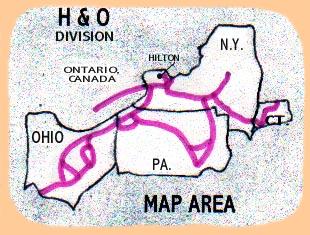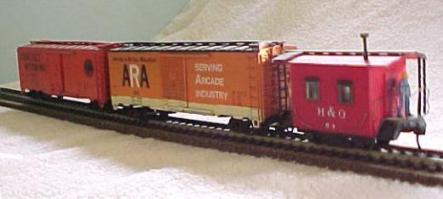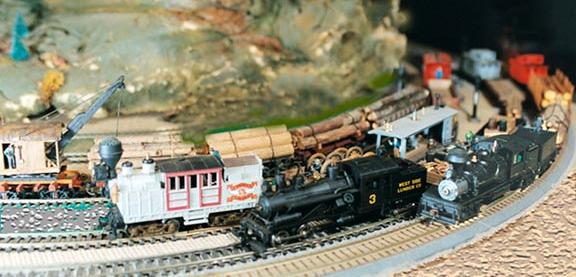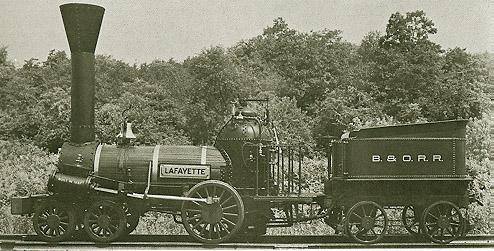|
|
|
|
|
|
|
|
|
|
|
|
|
|
|
|
|
|
|
|
|
|
|
Subsidiaries: |
|
|
|
H & O Division |
|
|
|
|
|
|
|
|
|
|
|
RR Memorabilia: |
|
|
|
|
|
|
|
|
|
|
|
|
|
|
|
|
|
Utilities: |
|
|
|
|
E-mail

|
|
|
H & O Division |
|
THE
“Hilton & Ohio” (H&O) HO-scale Division of the NORMANED RAILROAD began on 9/13/1978 and fell into virtual abandonment in April 1984
when a bad windstorm caused a large tree in our neighbor's yard to fall into
ours, taking out the electrical power lines to our house and starting a fire
which burned out the old fuse panel in the basement. Replacement of the fuse
panel with a circuit breaker system, upgrading of the electrical service to
the then current standards, and relocating the electrical meter to the
exterior of the house required me to break apart a large section of this
layout in order to provide room for electricians to do the necessary work. |

|
The
H&O Division of the NORMANED RR boasts the “largest” known display
commemorating the Golden Spike ceremony on May 10, 1869, which joined
the nation's East and West at Promontory, Utah, and launched the first
trans-continental railroad route. Here, HO models of the Central
Pacific's engine “Jupiter” (left), and the Union Pacific's No. 119
meet head-to-head in this “reinactment.” |
This trauma
put my six-year enthusiasm for HO-scale into a coma from which only the
inspiration of this present (2000/2004) documentation project has brought
about a glimmer of awakening after being virtually dormant for more than 16
years. (Although a few new HO-gauge items have been acquired for the
collection from time-to-time during that hiatus, the layout damage has never
been repaired and the “carcass” of the H&O [like the NORMANED]
has been exposed, through neglect and absolutely no attempt at maintenance
or protection of any kind, to an accumulation of dust, dirt, dampness and
the exploration of the ever-present local squirrel population). |

|
Above: A family of passengers heads for the single-car
combine train waiting at the Hilton terminus of the Hilton & Ohio
Division of the NORMANED RR. To the left of the depot can be seen
(left to right) portions of the Masonic Hall, windows in
second-floor apartment rooms over the village dry goods store, and
a barber shop. The roofs are not missing from these buildings, as
it may appear; they have flat roofs and the Masonic Building and
little barber shop have added false-front façades in keeping with
much of the architectual style of the period in this small
village. The train will have to back out of this spur track to
rejoin the main line. |
|
|
Right: This “composite collage” of separate photos
illustrates the way these model buildings would have appeared in
Hilton, N.Y. if placed in the same relative positions as the real
structures which they represent once stood. This corner, at Main and
Hovey Streets, was only a short block away from the train depot. The
Rome, Watertown & Ogdensburg RR station was behind the area where
the Arlington Hotel appears
here, but across the tracks from the hotel (out of sight in this
view). Although the other three buildings are the same ones that
appear alongside the depot on the H&O layout picture above this one
(with the train), the hotel is in O-scale and is located in
Panthorne on THE NORMANED
RAILROAD. They have been sized and rearranged here by computer to
appear as if they had been modeled together in the same scale to
represent their actual locations. |
|
During these
past 16 years, whenever I was required to be in that part of the basement
where the H&O “ruins” remain, I often would look longingly and lovingly over
the busted layout with reflections of its past splendor. Portions where I
had been able to restore electrical power with jumper wire and alligator
clips had allowed me to indulge myself on no more than only a very
occasional (less than annual, even) visit to run a locomotive or two (and
perhaps three or four cars) over short lengths of track which had somehow
escaped heavy corrosion and/or oxidation.
Actually, HO-scale had become the leader by far in U.S. model
railroading from even before my interest in the hobby first took root in
mid-century. However, I had strongly resisted any serious interest in that
most popular scale for nearly 15 years. Then, however, in 1978, the virtual
abandonment of the D-N-D Division serendipitously
opened up some space utilization possibilities (model railroaders seem to be
keenly alert to any new ways to make more room for their empires).
I began to think about the idea of building “a small display” with
some track and turnouts where I could “practice operation” (only on
occasion) of the few HO train items which I had acquired now and again on
impulse, simply because they had appealed to me in some particular or
peculiar way at the time.

|
Map
depicts how the imagined route of the H&O Division would serve
directly, through connections or interchanges, the fanciful
four-state and two-nation area of The NORMANED RAILROAD Co. and its
subsidiaries in order to explicate the use of the variety of rolling
stock which may be observed using its trackage. |
|
The H&O was thus conceived with a plan in mind. The first step was to
purchase a 10-inch x 8-ft. piece of pressed board for constructing a
small HO-gauge switching layout in a basement room which had
originally been built by my son Ned and me to house his
photographic darkroom. I had later used this space as a short-wave radio
“Communications Center,” which had been moved recently to my “office”; in
daughter Norma's second-floor former bedroom where the D-N-D Division had
been built and housed before its relocation to and repose in the third-floor
attic.
The switching layout building began and progressed at a pretty good
pace, and it was “entertaining” for me to run an engine around and move a
few cars . . . but the time came that it seemed reasonable (to me) that if
this long narrow segment could be moved to a different spot, the “HO room”
would be just about the right size to hold a “small circle or two” with up
to 22-inch minimum radius track in order to “show off” a train (or two)
running continuously and simultaneously.
What was (up until this point in time) a workshop behind one of the
walls of this small room had some built-in shelving along one side. One of
the shelves “just happened” to be exactly the right height and length to
hold the long and narrow switching layout, so (not without some sweat and
swearing) it was relocated there. Work began immediately, filling the former
darkroom cum radio shack with a wall-to-wall benchwork (leaving a central
access hatch), upon which to install “a small circle of track.” |
|
When this
“small circle” was completed, it contained not two, but four continuous
loops, a double track crossover, a long passing siding, a branchline ending
with a siding and house track at Hilton, and an independent point-to-point
trolley line. We named this segment “The Hilton Module” (see photos above
on this page). |
|
|
|
It was now the 1980s, and model railroaders were
discovering transistors, computers, LEDs and many other sophisticated
gadgets of the fledging new technology. One of my pride achievements was the
design, building and wiring (with no other help) of a magnificent control
panel and making it operable on this “spaghetti bowl” of HO track, using a
triple-control DC power pack along with a then state-of-the-art
transistorized throttle attachment.

|
Bundles of wires and dozens of terminal strip connections leading to
electrical toggle switches, panel lights, and H&O Division layout
trackage are visible in the control panel interior. The
three-circuit throttle pack is at the left. |
|
The real surprise to the rest of the family was that when
I completed the control panel and connected it to the layout, the trains
went where they were supposed to go and the separately AC-powered panel
train location and turnout position lights blinked in white, red and green
at the touch of the corresponding toggle switches and buttons on the control
panel. And I can not recall ever having had a bad wreck or “cornfield meet”
while handling trains on this layout, even when using the optional dual cab
control which I had built into the operation.
But we were just getting started -
The HO “bug” had bitten, and its effect was exponential, especially
when, from early 1981 until the Spring of 1984 (only about a month before
the occurrence of the windstorm wreckage), I had become involved in
part-time hobby shop retailing - first as an evening and weekend employee of
a local train store, and then for about a year and a half as proprietor of
my own small shop, “The Hobby Studio” - selling and repairing model trains
as a sideline to my hobby. These endeavors gave me not only a chance to
become more aware of just how much HO-scale dominated the hobby, but also
what a massive amount of material there was to select from. It also enabled
me to acquire considerable equipment with employees' and dealer discounts,
and my collection grew rapidly. |
|
Once each year (in observance of “Presidents' Day” in February),
the Lincoln funeral car is displayed on a siding of the H&O
Division. The car had been commissioned in 1863 as President
Abraham Lincoln's private car, and was completed in February of
1865. However, on April 21, 1865, the car made its first and only
trip when it carried the body of the assassinated 16th President
of the U.S. in a funeral train from Washington, D.C. to
Springfield, Illinois. The President's body was accompanied by
that of his disinterred son, Willie, who had died in 1862 and was
encrypted in a vault in Oak Hill Cemetery, being then moved to
Springfield to be buried with his father.
|
|
|
|
Additionally, I believe I began to convert from
being a “model railroader” to becoming a “railroad modeler” - that is I
spent more time building and detailing trains, fancy track configurations,
buildings and other structures than I did creating and operating
highly-scenic scale model railroads. But I did build quite a collection,
some of which was sold in my store, but most of which I stored for future
use on the H&O.
While involved in this phase, however, I continued
to expand the H&O Division. First, I built a platform on the workbench
(opposite the relocated switching yard layout) upon which I modeled an
eight-track version of the now abandoned Bison Yard in Buffalo, N.Y., with a
long lead track to the yard using two triple-wye turnouts, plus a by-pass
track on new benchwork around the room to connect the four sides of the
former workshop with a complete loop. This required ducking under a 5-ft.
long truss bridge to get to the controls. In the center of all this, I added
a 4-ft. square service and maintenance area with an Atlas nine-position
electrically-operated sequencing turntable, serving 16 tracks (figure that
one out!). |

|
The lonely brakeman stands guard on the rear platform of H&O
Division “Bobber” Caboose #C 1, along with freight cars from two
other area railroads. The Arcade and Attica (ARA) RR boxcar
appears to have broken a spring or derailed a wheel on a bad track
joint and the locomotive has gone for help. The other car, from
the Genesee & Wyoming (GNW), seems “perfectly healthy.”
|
|
|
|
Then, I
installed dual cab control with two transistorized walk-around throttles for
the two yards, a separate power source and cab for the turntable area, and a
super-sophisticated power pack for one-operator control of the whole works
from a main panel. The hardest (but true) part of all this to believe is
that it worked . . . . But it really did!
The H&O Bison yard is a beauty, with a double
crossover, slip-switches, engine house, and even some narrow- and dual-gauge
trackage for interchange with an imagined future logging operation. Nearly
all of the trackage in both yards was filled with my favorite locomotives
and a lot of maintenance-of-way rolling stock. On shelves in an adjoining
closet were stacked dozens of customized private name freight cars and other
rolling stock with “no place to go.” |

|
The H & O Division's roster of logging equipment is displayed
above in a staging area. Shown with their various consists are
(left to right) a Barnhart loader (by Keystone Locomotive Works)
and three geared steam locomotives-- a Model Die Casting Class A
Climax, a Rivarossi two-truck Heisler, and a Bachmann 80-ton
three-truck Shay.
|
|
|
|
Meanwhile, as
the turntable and service area had been added to the side of the relocated
“long and narrow switching layout,” along with track and electrical
connections which provided access to other areas of the “pike,” this entire
“shelf” segment was now identified as the Division’s “Mainline
Service & Interchange Module,” used by all possible routes of the
layout.
Layout-wise, the only thing now remaining was to figure out how I
could connect the two back-to-back segments - one in the old radio room and
the other in the former workshop, but with a solid wall separating them. I
had to decide which was more likely - to go through the doorways, or through
the partition.
As it turned out, that decision never was made, as it was at this
point of progress that the partial demolition from the results of the
windstorm damage halted layout operations and badly tarnished my enthusiasm
(as described in the opening paragraph of this section). After this
set-back, my primary model railroading attention returned to the “parent” NORMANED
RR for approximately four years before the start of the dozen years of
“withdrawal.”
The H&O damage has not all been repaired (see next page, "The H & O Revival Begins"). It is awaiting the continuation
of the ongoing more complete restoration of the NORMANED
- “The O-gauge 'Phoenix'” (see Why this Web Site?).
|

|
Update: The
first Common Carrier railroad in the United States, the Baltimore &
Ohio, was established on July 4, 1828. The Lafayette, a 4-2-0
built by William Norris of Philadelphia in 1837, was the first B&O
locomotive with a horizontal boiler, and the earliest locomotive to
feature a leading truck. This recently-acquired (2001) Bachmann®
fine-scale HO model of the Lafayette rounds a curve on THE
NORMANED's H & O Division, pulling passenger cars created from sketches
drawn nearly 200 years ago. The accompanying photograph of the original
Lafayette locomotive is from the archives of the B&O Railroad; an
operating replica of the Lafayette, built in 1927, currently
resides at the B&O Railroad Museum in Baltimore, Maryland.
- |

|
| |

|
[ Home ]
|

|
|